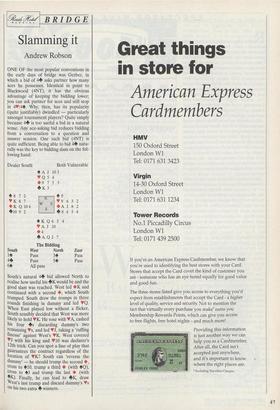BRIDGE
Slamming it
Andrew Robson
ONE OF the most popular conventions in the early days of bridge was Gerber, in which a bid of 4+ asks partner how many aces he possesses. Identical in point to Blackwood (4NT), it has the obvious advantage of keeping the bidding lower; you can ask partner for aces and still stop in 4V/44. Why, then, has its popularity (quite justifiably) dwindled — particularly amongst tournament players? Quite simply because 4+ is too useful a bid in a natural sense. Any ace-asking bid reduces bidding from a conversation to a question and answer session. One such bid (4NT) is quite sufficient. Being able to bid 44 natu- rally was the key to bidding slam on the fol- lowing hand: Dealer South Both Vulnerable The Bidding South West North East 14 Pass Pass 4+ Pass 54 Pass 64 All pass South's natural 441 bid allowed North to realise how useful his 4K would be and the good slam was reached. West led ♦K and continued with a second ♦, which South trumped. South drew the trumps in three rounds finishing in dummy and led ♦Q. When East played low without a flicker, South sensibly decided that West was more likely to hold YK. He rose with ♦A, cashed his four 4's discarding dummy's two remaining ♦s, and led 11J, taking a `ruffing finesse' against West's •K. West covered rJ with his king and ♦10 was declarer's 12th trick. Can you spot a line of play that guarantees the contract regardless of the location of ♦K? South can 'reverse the dummy' — he should trump the second ♦, Cross to 410, trump a third ♦ (with +Q), cross to 4J and trump the last ♦ (with 4K). Finally, he can lead to 4K, draw West's last trump and discard dummy's ♦s On his two extra 4 winners.


























































 Previous page
Previous page